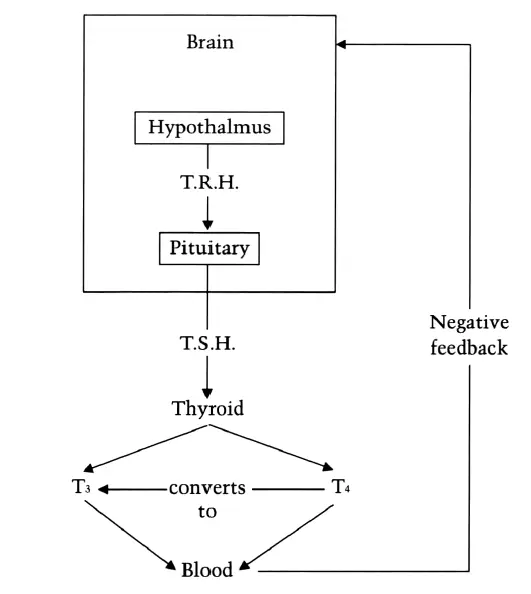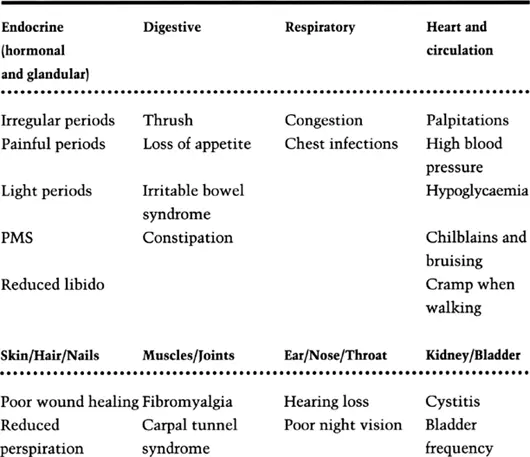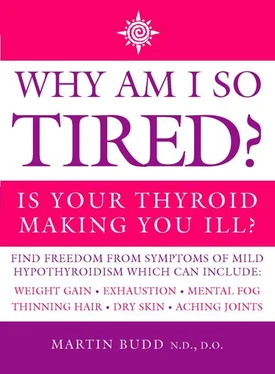The thyroid gland has a mental, as well as physical role. Our brains are influenced by a decline in our metabolic rate and symptoms similar to premature ageing can develop, including: poor short-term memory, mental fatigue, difficulty in concentrating, anxiety and moodiness. Therefore, you can see that if our thyroid is not working efficiently we may experience a whole range of different symptoms!
Your thyroid gland lies at the front of your neck, between your breastbone and Adam’s apple. The gland lies across your windpipe and has a butterfly-like appearance; two lobes are joined by a narrow band of tissue known as an ‘isthmus’.
You can palpate your own thyroid gland by stretching your neck and pulling your head back. If you then swallow you may see or feel the gland rise and fall. Not all of us can see or palpate our thyroid, so do not be concerned if this exercise does not work. Men’s thyroids can usually be located more easily than women’s.
There is considerable variation in the size and weight of the thyroid. The weight can vary from 8g to 50g. It is also possible to be born without a thyroid gland (this is called cretinism). Thyroid tissue can exist and function some distance from the main gland, this aberrant or anomalous tissue — coupled with the great range in size and weight — demonstrates that there is no standard thyroid gland.
What is ‘Hypothyroidism’ ?
In some people, the thyroid gland does not work correctly and this can be due to any number of causes (see Appendix). When the thyroid does not work as hard as it should and becomes ‘underactive’ the patient is diagnosed with ‘hypothyroidism’, (‘hypo’ is Greek for ‘under’). Hypothyroidism can also be called ‘myxoedema’. This term is used in more severe cases of hypothyroidism and refers to a type of body swelling which can occur. ‘Euthyroidism’ means a normal thyroid and ‘hyperthyroidism’ refers to an overactive thyroid.

Around 10 per cent of the adult population of Great Britain suffer symptoms caused by mild hypothyroidism. American doctors and researchers have put the figure in the US even higher.

As I have mentioned, when the gland becomes underactive every aspect of our metabolism is acted upon and the levels of water, proteins, fats and cholesterol all increase. Therefore, the functions mentioned above — including temperature, immunity, energy, growth, sex drive, memory — are all adversely affected and usually decrease.

It is quite incorrect to say that hypothyroidism is a female complaint. Approximately 10 per cent of the 300 thyroid patients that I have treated over the last four years have been men. Although the majority of my patients are in the over-fifty range, I have treated teenagers with a diagnosis of mild hypothyroidism, who have responded well to the appropriate treatment.

One of the commonest symptoms of an underactive thyroid — and one which greatly concerns us — is tiredness or fatigue. This is a result of the slowing down of all the body’s systems and organs.
Many patients with an underactive thyroid gland comment that they ‘wake up some time after their eyes are open!’. The thyroid is the body’s internal clock and when the gland is inefficient or under-active the metabolism does not usually recover from the effects of sleep until around mid-day.
The thyroid gland releases two hormones which in turn influence virtually every cell in the body. These two essential hormones are thyroxine(T 4) and triiodothyronine(T 3). The T 4and T 3denotes the umber of iodine atoms in the hormone molecules, iodine being the chief constituent of the thyroid hormones.
Only T 3is chemically active at cell level, the non-active T 4is converted to T 5only when required. There exists around 50 times more T 4than T 3in the blood, and the two hormones are linked to, and transported in the blood by carrier proteins. It is only when the hormones are free of the protein (at which time they are measured in the blood as free T 4and free T 3) that they become chemically active.
The thyroid is controlled by the pituitary gland. The pituitary responds to a low level of blood thyroid hormones by releasing thyroid stimulating hormone (TSH).
The pituitary gland is under the control of the hypothalamus. This part of the brain releases thyrotrophin releasing hormone (TRH) which regulates pituitary activity.

Figure 1:Thyroid control

Calcitonin
This hormone is also released by the thyroid. Its function is to regulate the blood level of calcium by reducing excessively high levels.

What are the Symptoms of Hypothyroidism?
As the thyroid influences every system, organ and muscle in the body, the potential list of symptoms is enormous. The pattern of symptoms a sufferer may experience depends on human individuality, which results from heredity, diet, immune efficiency and stress levels. Our genetic predisposition also plays an important role in influencing the systems and organs that may be disturbed by a thyroid deficiency.
However, there are certain leading symptoms that are common to the greater majority of patients, these are included in the table below.
Common symptoms of hypothyroidism


How is Hypothyroidism Tested?
Modern blood testing is seen as an essential component in diagnosing hypothyroidism. Doctors measure the amount of thyroxine (T 4) and triiodothyronine (T 3) to assess how well the gland is working. (They also measure free T 4and free T 3.) Many doctors and researchers also measure the amount of TSH or thyrotropin in your blood stream. TSH is released when there is too little T 4so the more TSH you have in your body the more underactive your thyroid (and the less TSH the more overactive your thyroid).
Читать дальше
















